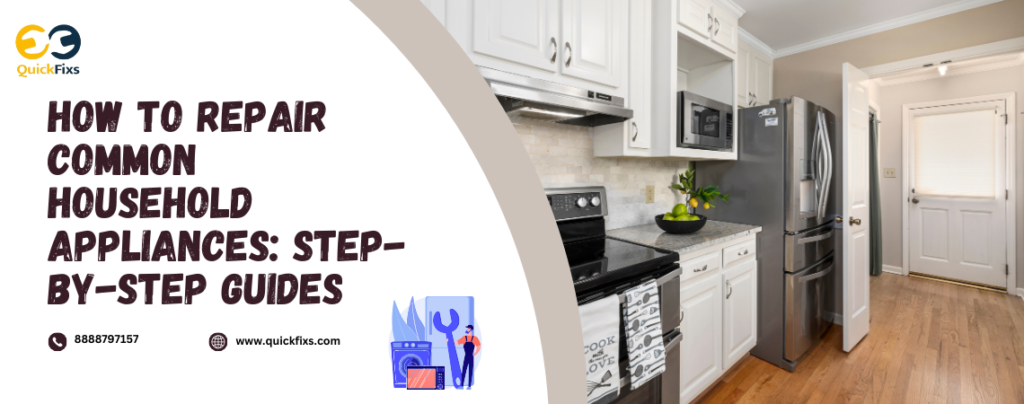
How to Repair Common Household Appliances: Step-by-Step Guides
Home appliances play an efficient role in making our life easier, now it is a need of every individual. but like all things they can break over time. Whether it is a defect in the washing machine, a noisy refrigerator or a hot oven, you can save money on repairing the equipment and preventing unnecessary stress. Before calling a repair technician, it is important to check if can you solve the problem by yourself or not.
Here’s a guide to repairing some of the most common appliances.
- How to repair the washing machine
Problem: The washer is not a drain.
Step 1: Check the drain hose of washing machines. The drain can be closed. Remove the hose and clean any debris.
Step 2: Observe the pump. A malfunctioning drain pump can be a criminal. Unclogged or replaced the pump if necessary.
- How to repair a refrigerator
Problem: The refrigerator has not cooled properly.
Step 1: Check the temperature settings. Make sure the thermostat is set to the correct temperature. If the settings are nice, go to other solutions.
Step 2: Clean the capacitor coil. Dust and dirt can accumulate on the capacitor coil, which can overheat the refrigerator. Clean the coil with a bobbin or vacuum.
Step 3: Check the door seal. If the door seal is torn or spoiled, the cold air can survive so that the refrigerator can work hard. Change the seal when needed.
Step 4: Observe the evaporation fan. If the fan does not work, it can prevent the cold air from sending properly. Change an incorrect fan motor.
Problem: The refrigerator makes a strange noise.
Step 1: Identify the noise source. Sometimes the noise comes from the capacitor fan or evaporation fan. You may need to separate the refrigerator to reach these parts.
Step 2: Grease fan motors. If fan motors are the cause of noise, lubrication can temporarily solve the problem.
Step 3: Change the defective part. If lubrication does not work, you may need to replace the fan motor or compressor.
- How to repair microwave oven
Problem: Microwave won’t heat.
Step 1: Check the power. Ensure the microwave is plugged in and the outlet is working.
Step 2: Inspect the door switch. A faulty door switch can prevent the microwave from operating. If the switch is defective, replace it.
Step 3: Test the magnetron. The magnetron is the part that generates the microwave’s heat. If it’s faulty, it will need to be replaced.
Problem: The microwave is making a loud noise.
Step 1: Clean the microwave. A loud noise might be caused by food debris. Clean the microwave thoroughly to ensure no obstructions are causing the noise.
Step 2: Check the fan motor. It might be worn out and producing a loud sound. If so, replace it.
- How to Repair an Oven
Problem: The oven, not heating.
Step 1: Check the power supply. Ensure the oven is properly connected to the power source and the circuit breaker is on.
Step 2: Test the heating element. If the oven isn’t heating, the heating element might be faulty. Test it with a multimeter and replace it if necessary.
Step 3: Inspect the thermostat. A malfunctioning thermostat can prevent the oven from reaching the desired temperature. If it’s defective, replace it.
Problem: The oven door won’t close.
Step 1: Inspect the door hinges for damage. If they are worn out, they may need to be replaced.
Step 2: Check the door seal. A worn door seal can cause issues with closing. If the seal is damaged, replace it.
- How to repair a vacuum cleaner
Problem: The vacuum cleaner is not on.
Step 1: Check the power cord. Make sure the vacuum is connected correctly. Check the power cord for visual damage or frightening. If damaged, it may require replacement.
Step 2: Observe the fuse. Many vacuum cleaners have a built fuse. If the fuse is blown, replace it with one of the same type and rank.
Step 3: Test switch. If the vacuum is still not in operation, the power switch may be deficient. Test the switch with a multimeter and change it if necessary.
Problem: Vacuum cleaner has less suction.
Step 1: Check the filter. A closed filter can reduce suction power. Clean or replace the filter to restore the correct airflow.
Step 2: Check the hose. The snake blocking can also reduce the suction. Separate the hose and clean waste.
Step 3: Follow the scroll brush. A jam or complicated roll brush can affect the suction. Remove hair or debris packed around the brush and make sure it rotates freely.
How to repair a geyser
Problem: Geyser water is not hot
Step 1: Check the power supply. Make sure the geyser is plugged, the switch is on, and the electrical outlet works.
Step 2: Check the thermostat. If the temperature setting is too low, the geyser cannot heat the water properly. Adjust the thermostat in a high setting and re-test.
Step 3: Check the heating element. If the heating element is deficient or damaged, it may need to be replaced. This repair may require a professional.
Step 4: Check the water reservoir. Make sure the tank has enough water. If the tank is empty or almost empty, the geyser cannot heat the water properly.
Problem: Geyses are leaking water
Step 1: Observer Geyser tank. Make sure there are no visible cracks or disadvantages to the tank. If the tank leaks, it may need to be replaced.
Step 2: Check the pressure relief valve of the geyser. If the valve is deficient or damaged, it can cause leaks. Change or repair the valve as required.
Step 3: Check the inlet and outlet pipes. Make sure the pipes are properly connected and not torn or damaged. Tighten a loose connection and replace a broken pipe.
Conclusion:
You can repair appliances at home you just need the right tools and a little bit of patience, it looks intermediating first but you can fix yourself. Remember to always unplug the appliance before attempting any repairs, and if you’re ever unsure, consult the user manual or call a professional. Taking the time to learn basic repairs can save you money and extend the life of your appliances.
- About Us
- Media
- Blog
- Customer Stories
Our Services Available At: Pune and Pimpri-Chinchwad City only. But we are excited to start our Services in other major cities in India soon.





© 2015-2024 www.quickfixs.com. All rights reserved.



